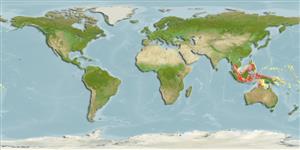Classification / Names
Common names from other countries
Main reference
Size / Weight / Age
Max length : 215 cm TL male/unsexed; (Ref. 84284); 213.0 cm TL (female)
Environment
Marine; brackish; pelagic-neritic; depth range 16 - 37 m (Ref. 84284)
Climate / Range
Tropical, preferred ?; 20°N - 10°S, 95°E - 128°E (Ref. 114953)
Distribution
Indo-Malay: from Java (Indonesia) to Thailand, including Borneo, Singapore
and the Philippines..
Countries | FAO areas | Ecosystems | Occurrences | Introductions
Short description
This moderate-sized species is distinguished by the following set of characters: snout broadly wedge-shaped; preoral snout 16-22% of total length; eye small, length 3.1-4.0 in preorbital snout; interorbital space 2.2-2.7 in preorbital snout; mouth hardly bowed, with strong indentation on upper jaw near symphysis and strong protuberance on lower jaw; tooth rows in upper jaw about 52 (holotype); dorsal snout no spines; dorsal tip of snout with no rostral spines or spines; supraorbital spines small but well differentiated, extending from preorbit to end of spiracle; spines of mid-dorsal row relatively well developed; two obvious rows of small scapular spines on each side; origin of first dorsal fin over origin of pelvic fin bases; predorsal space 42-48% of total length; colour pale greyish green above with 3-4 rows of large, white spots extending along the tail; black pectoral marking distinct, usually closely surrounded with 4 white spots (occasionally 3); anterior pectoral disc with narrow whitish margin; orbital membrane with a pair of dark, widely spaced, recurved lines; interorbital space with no alternating light and dark markings; propterygial radials 1-8 + 20-23, mesopterygial radials 4-6, neopterygial radials 4-7, metapterygial radials 23-29, total radials 57-68 (inc. free radials); vertebrae with 12-14 synarcual centra, 18-28 monospondylous precaudal centra, 78-88 precaudal free centra, 33-40 diplospondylous caudal (free) centra, 113-126 total free centra, 127-139 total centra (including synarcual centra) (Ref. 84284).
IUCN Red List Status (Ref. 115185)
Threat to humans
Harmless
Human uses
More information
Age/SizeGrowthLength-weightLength-lengthLength-frequenciesMorphometricsMorphologyLarvaeLarval dynamicsRecruitmentAbundance
ReferencesAquacultureAquaculture profileStrainsGeneticsAllele frequenciesHeritabilityDiseasesProcessingMass conversion
Tools
Special reports
Download XML
Internet sources
Estimates of some properties based on models
Phylogenetic diversity index
PD50 = 0.5049 many relatives (e.g. carps) 0.5 - 2.0 few relatives (e.g. lungfishes)
Trophic Level
3.6 ±0.6 se; Based on size and trophs of closest relatives
Resilience
Vulnerability
Very high vulnerability (78 of 100)
Price category
